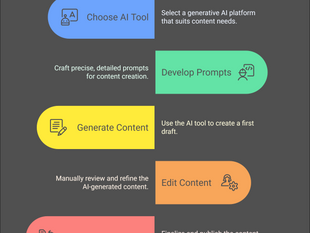

Craft effective prompts: Write clear, specific instructions that guide the AI toward your desired output. Instead of "write a story," try "write a 300-word mystery story about a missing antique watch, set in modern-day Paris, with a surprising twist ending." The more specific your prompt, the better the results you'll get.
Choose the right generation parameters: Understand and adjust settings like temperature (controls randomness) and max tokens (output length). Lower temperature (0.2-0.4) works better for factual or business content, while higher values (0.6-0.8) are better for creative writing. Always set an appropriate length limit to avoid cut-off responses.
Implement iteration and refinement: Don't settle for the first output. Use the AI's initial generation as a starting point, then refine it with follow-up prompts. For example, after generating a customer service response, you might prompt "Make this response more empathetic" or "Simplify the language for clarity."
Apply context and constraints: Provide relevant background information and specific requirements in your prompts. For a customer service scenario, include details like company tone of voice, key policies, or specific product information. For story generation, specify genre, style, length, and target audience.
Review and edit AI outputs: Always validate generated content for accuracy, appropriateness, and quality. Check for potential biases, factual errors, or inconsistencies. For business use, ensure the tone matches your brand voice and modify content to maintain consistency with your style guide.
Frequently Asked Questions About Generative AI Text Generation
Q1: How Can AI Automation Transform Content Creation Processes?
AI automation is revolutionizing content creation by dramatically reducing time and effort. Generative AI tools can produce first drafts, brainstorm ideas, and generate content across multiple formats in minutes. By automating repetitive writing tasks, businesses and creators can focus on high-value strategic work. AI can generate blog posts, social media content, marketing copy, and even creative writing, allowing teams to scale content production efficiently while maintaining quality and reducing manual workload.
Q2: What Are the Key Ethical Considerations When Using Generative AI for Text Generation?
Ethical use of generative AI involves transparency, proper attribution, and avoiding plagiarism. Users must disclose AI-assisted content, ensure original thinking, and use AI as a collaborative tool rather than a complete replacement for human creativity. Key considerations include verifying factual accuracy, maintaining original voice, respecting intellectual property, and being aware of potential biases in AI-generated text. Responsible AI use means treating generated content as a starting point for human refinement and critical thinking.
Q3: How Precise Can Generative AI Prompts Be for Optimal Results?
Effective AI prompts are highly specific and contextual. Instead of broad instructions like "write an article," craft detailed prompts specifying tone, length, audience, and key points. For example, "Write a 500-word beginner-friendly tech article about AI automation in marketing, using a conversational tone and including two industry-specific examples." The more precise your prompt, the more accurately the generative AI can meet your exact content requirements.
Q4: What Technical Parameters Should I Adjust When Using Generative AI?
Understanding and manipulating technical parameters is crucial for quality text generation. Temperature settings control creativity and randomness (lower values like 0.2 produce more focused, factual content), while max tokens determine output length. Experiment with different settings based on your content type: use lower temperatures for technical writing and higher temperatures for creative projects. Always set appropriate length limits to prevent truncated responses.
Q5: Can Generative AI Replace Human Writers Completely?
Generative AI is a powerful tool but cannot fully replace human writers. It excels at generating drafts, providing creative suggestions, and automating routine writing tasks. However, human expertise remains critical for nuanced editing, maintaining authentic voice, ensuring emotional intelligence, and applying complex critical thinking. The most effective approach combines AI efficiency with human creativity, using generative AI as a collaborative assistant that enhances rather than replaces human writing skills.





